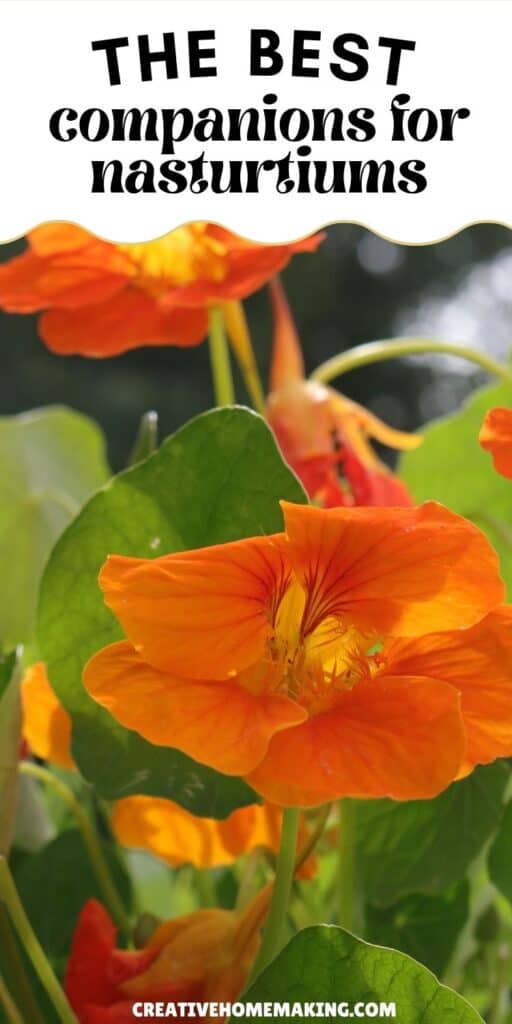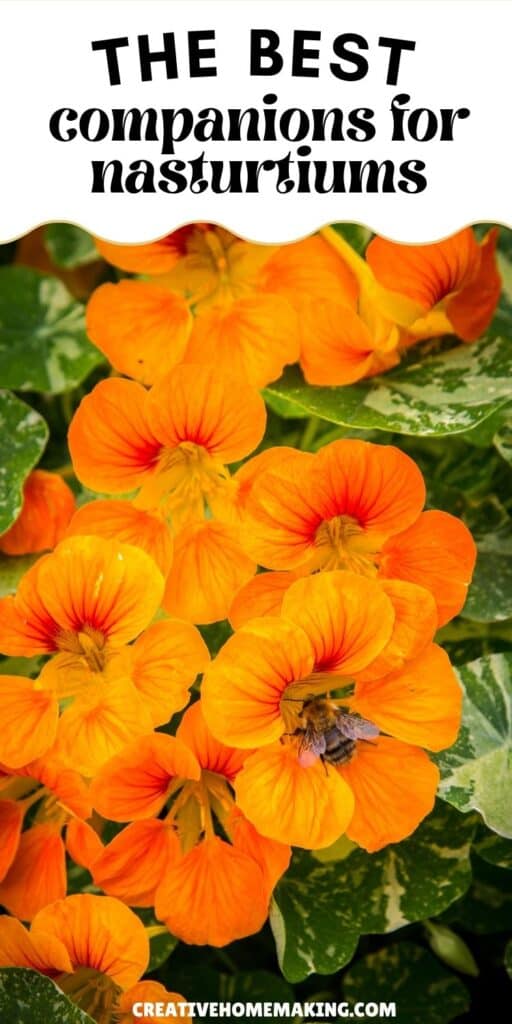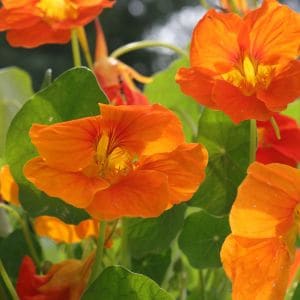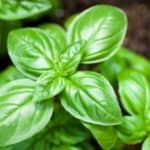If you want to make the most out of your garden, planting nasturtiums with the right companion plants is a smart move. Nasturtiums work well with many vegetables and flowers like tomatoes, cucumbers, cabbage, and marigolds because they help keep pests away and attract pollinators. Pairing these plants can boost the health and growth of your garden naturally.
This post may contain affiliate links.
Nasturtiums don’t just look pretty with their bright flowers—they also serve as natural pest control by attracting bugs like aphids away from your main crops. When you choose the right neighbors for nasturtiums, you’re helping your whole garden thrive without relying on chemicals.
Knowing which plants grow well alongside nasturtiums can make gardening easier and more fun. Whether you’re growing vegetables, fruits, or flowers, companion planting with nasturtiums adds color, protects your plants, and supports a healthier garden ecosystem.
Related Article: What Not to Plant with Nasturtiums: Friendly Tips for a Thriving Garden

Best Companion Plants for Nasturtiums
Nasturtiums work well with many plants by protecting them from pests and helping pollinators. Choosing the right companions depends on what you want to grow alongside your nasturtiums.
Vegetables That Thrive With Nasturtiums
Vegetables like cucumbers, beans, broccoli, cabbage, radishes, and squash do well with nasturtiums. Nasturtiums attract pests away from these vegetables, acting as a natural trap crop. This means your veggies face less damage.
They also add ground cover, which helps keep weeds down and soil moist. Just keep in mind that nasturtiums prefer poorer soils, so they won’t compete much with your vegetables for nutrients.
Avoid planting tomatoes too close, as nasturtiums can compete with them and may hinder their growth.
Related Article: Companion Plants for Chives to Boost Your Garden’s Health and Flavor

Flowers That Pair Well With Nasturtiums
You can grow nasturtiums near fruit trees or other flowering plants that attract pollinators. Nasturtiums bring more bees and butterflies to your garden, which helps flowers and fruit set better.
Their bright, trailing flowers also add beauty and can cover bare ground. This cover reduces weeds and keeps pests like aphids away from other plants.
Nasturtiums prefer full sun and well-draining soil, so pick flowers that like similar conditions to avoid growth struggles.
Herbs to Grow Beside Nasturtiums
Herbs such as basil, chives, and parsley grow well near nasturtiums. These herbs benefit from nasturtiums’ pest-repelling abilities. They share similar light and water needs, which makes growing them together easier.
Avoid planting mints, sage, or thyme near nasturtiums because these herbs can compete for nutrients or overshadow the flowers. Stick to herbs that stay smaller or spread out instead of taking over the space.
This mix will help all plants stay healthy without fighting for resources.
Related Article: Best Companion Plants for Peonies to Brighten Your Garden Naturally
Designing a Companion Planting Garden With Nasturtiums
You can use nasturtiums to add beauty, protect plants from pests, and boost your garden’s food production. With a little planning, nasturtiums help your other plants grow better and healthier.
Creating Colorful Borders
Nasturtiums make great border plants because of their bright, jewel-toned flowers. Plant them along garden edges or around vegetable beds. Their trailing vines can spread nicely over soil or climb small supports.
Using nasturtiums for borders also helps shade the soil. This keeps it cooler and moist, which benefits nearby plants. Plus, their colorful blooms attract pollinators like bees and butterflies, helping your whole garden thrive.
Try mixing nasturtiums with low-growing herbs or leafy greens. The contrast in leaf shapes and colors adds interest and layers to your garden design. This makes your outdoor space lively and inviting.
Pest Control Strategies
Nasturtiums work as natural pest repellents. They attract pests like aphids, whiteflies, and squash bugs away from other vulnerable plants. This means your tomatoes or beans suffer less damage.
Plant nasturtiums near crops that pests usually attack. This setup is called a trap crop. It lures harmful insects to the nasturtiums instead of your vegetables.
Nasturtiums also attract beneficial insects that eat pests. Ladybugs and predatory wasps, for example, tend to stick around when nasturtiums are nearby. This helps keep your garden balanced and healthy without needing chemicals.
Maximizing Edible Yields
Including nasturtiums in your vegetable garden can improve yields. They enrich the soil by helping nitrogen stay available. This benefits nitrogen-loving plants like beans and leafy greens.
You can eat both nasturtium flowers and leaves. Their peppery taste adds a fresh zing to salads and garnish.
Plant nasturtiums near larger plants that provide some shade, like brassicas or cucumbers. The nasturtiums prefer some protection from strong sun. This pairing creates a healthier growing environment for both.
Using nasturtiums also reduces pest damage, so edible plants grow stronger and produce more fruit or leaves for you to enjoy.
Follow my nasturtiums board on Pinterest.




